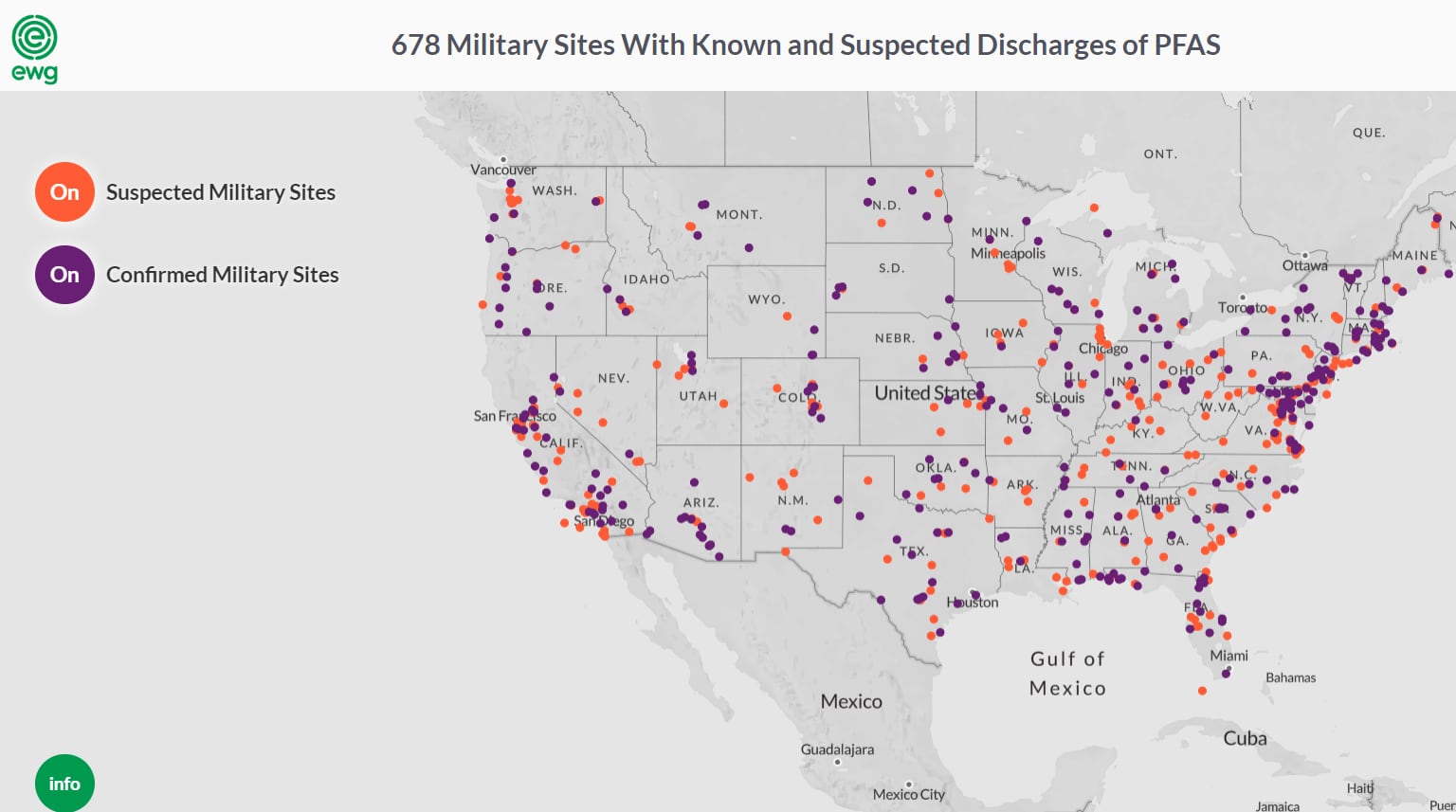There are nearly 700 military installations with either confirmed or suspected ground water contamination caused by fire-fighting foam using in vehicle and aircraft mishaps, according to new data released Thursday by the Environmental Working Group.
Cancer-linked per- and polyfluoroalkyl substances, collectively known as PFAS, have been confirmed at 328 sites, according to Pentagon data analyzed by EWG. and are suspected on about 350 more Defense Department installations and sites.
“DoD officials have understood the risks of AFFF since at least the early 1970′s, when the Navy and Air Force did their own studies on the toxicity of PFAS in fish, and the early 1980s when the Air Force conducted its own animal studies,” Scott Faber, EWG’s senior vice president for government affairs, told reporters in a phone conference on Thursday.

On 14 installations, Faber added, PFAS levels measured 1 million parts-per-trillion in the ground water, while the Environmental Protection Agency sets 70 parts-per-trillion as the maximum safe level.
Some places topped even that number. Naval Weapons Station China Lake, California, reported 8 million parts-per-trillion in its ground water, per a 2017 test. Holloman Air Force Base, New Mexico, reported 1.06 million parts-per-trillion.
Though bases have put in place filtration systems to protect drinking water on bases, they do not eliminate exposure.
“Unfortunately DoD hasn’t moved as quickly as Congress would have liked," Faber said, both when comes to transitioning away from AFFF, as well as cleaning up pollution on and near bases.
Fire-fighting foam is no longer used in training, which has vastly reduced the frequency of contamination on and near bases. But perfluorooctanesulfonic and perfluorooctanoic acids do not break down in the body, meaning that a lifetime drinking water on military installations ― or living near one ― results in irreversible build-up of the chemicals.
Congress has gotten involved in recent years, including in the latest National Defense Authorization Act, requiring the Pentagon to find a replacement for AFFF by 2024, and giving hundreds of billions to support clean-up efforts.
RELATED

It has fallen short of one big designation that environmentalists have pushed for, however: getting PFAS classified as toxic under the Safe Drinking Water, Safe Water and Clean Air acts, which would set a timetable and put billions of dollars behind clean-up efforts.
The measure is part of the House version of the 2021 NDAA bill, as it was last year, though it has failed to get Senate Republican support.
Though the military has responded in fits and starts, in terms of reducing and cleaning up contamination, in July Defense Secretary Mark Esper stood up a dedicated PFAS task force to study the issue and make recommendations. The first progress report came out in March, establishing priorities to come up with a replacement for AFFF, study the health effects of PFAS on humans and make plans for cleaning up old contamination.
“The task force is focused on continuing to educate DoD health care providers and their patients, monitoring PFAS research, and preparing to offer annual testing of DOD firefighters’ blood,” according to a March 13 news release.
The department is also investing $49 billion in research for a new fire-fighting foam, though possible candidates so far have not proven as effective.
Last fall, Wright-Patterson Air Force Base, Ohio, hosted a test of the Enhanced Contact Plasma Reactor, which has been shown to break down PFAS.
"This is the only technology that actually destroys PFAS molecules that has been demonstrated at this scale, it doesn’t just remove them from water,” co-principal investigator Tom Holsen said in a November release. “All of the other demonstrations that we’re aware of remove it from the water through filtration so there is still a PFAS-containing waste. Our method actually destroys PFAS.”
Meghann Myers is the Pentagon bureau chief at Military Times. She covers operations, policy, personnel, leadership and other issues affecting service members.
